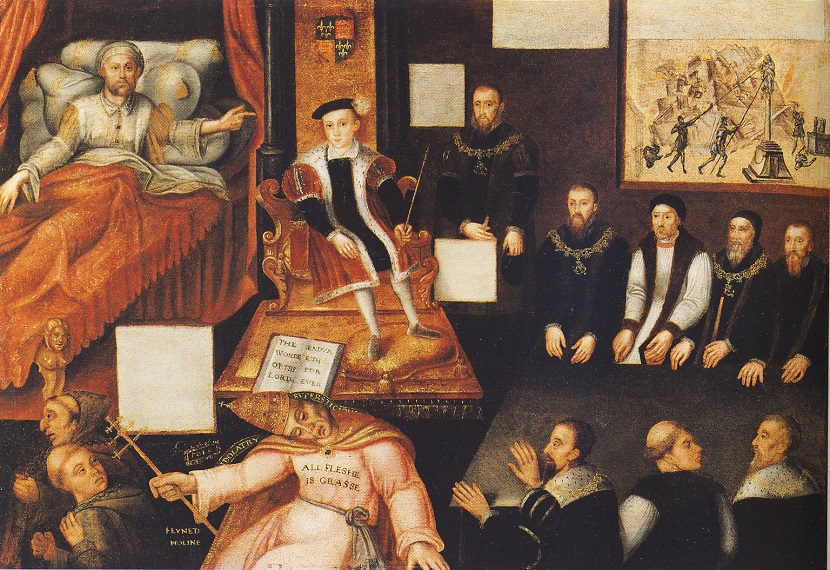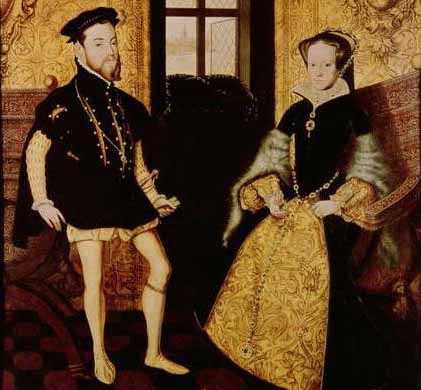
Religious Changes

Introduction
The twenty-five years after 1533 saw great changes in religion in England.
Henry VIII
Henry VIII had broken away from the Pope, so he was no longer a Roman Catholic – but he was fiercely Catholic. In 1539, Henry passed the Six Articles. Priests who married, and anyone who did not believe in transubstantiation, would be burned to death.
Ordinary people were forbidden to read the Bible. About five hundred Protestants were arrested, and some were burned to death (including a woman called Anne Askew, who was so cruelly tortured that she had to be carried to the stake).
Edward VI

When Henry died in 1547, his son Edward was only nine years old. He was too young to rule on his own, so a regent ruled the country for him. Edward's first regent was his uncle, Edward Seymour, the Duke of Somerset, who was a Protestant.
Under Somerset, there was a religious revolution in England. The Latin Mass was abolished and a new prayer book was published – in the English language. Statues of the saints were smashed, and pictures on church walls were whitewashed. Stone altars were thrown out, and replaced by wooden Communion tables. Protestant missionaries were sent out to different parts of England, with Bibles, to teach people the new ways.
Many people hated the new services. In 1549 the people of Devon and Cornwall rose in rebellion against the new prayer book saying that 'it is but like a Christmas game'. The rebels were defeated, and the priests who had led it were hanged from their own steeples. The Duke of Somerset fell from power, but his successor, the Duke of Northumberland, was even more fiercely Protestant. A new, stricter prayer book was published. Catholic bishops were sent to the Tower.
After you have studied this webpage, answer the question sheet by clicking on the 'Time to Work' icon at the top of the page.
Links:
The following websites will help you research further:
The English Reformation, 1547-58:
• Timeline • History Learning Site on the English Reformation 1547-1550, 1550-1553 and 1553-1558 • BBC Bitesize - excellent
•
School website on the English Reformation
• S-Cool revision notes on Edward VI
and Mary
• Essay by Stephen Lee on people's reactions to the changes
(starts at the bottom of the page)
1 A Religious Propaganda Painting
This painting from 1548 celebrates Edward VI's Reformation of the Church. On the left, Henry VIII gives Edward his blessing. On the right are the Duke of Somerset and the royal Council. Beneath Edward's feet, the Pope and monks are crushed by the Bible. Through the window reformers can be seen smashing statues of the saints and the Virgin Mary.

Introduction – continued
Mary

And then everything changed. Edward died in 1553, and Mary (Henry's elder daughter) became queen. She was a Catholic, and wanted to make England a Roman Catholic country once again.
The Catholic bishops came out of the Tower; Protestant ministers went in. Mary brought back the Latin church services and Bibles. She was advised by Reginald Pole, an English Cardinal who came to England from Rome. In 1554 Queen and Parliament knelt before him and begged to be reunited with Rome. In the same near, Mary married the son of the King of Spain, Prince Philip. Spain was a Catholic country.
Mary offered the Protestants a choice: 'Turn or Burn'. About three hundred Protestants chose to be burned. But times had changed in England. Many of Mary's victims, ordinary people, died like heroes. The burnings did not turn people back to Rome, they made people hate Roman Catholicism. Mary became more and more unpopular. People started to call her 'Bloody Mary'. When she died in 1558, people rejoiced.
2 The Spanish Marriage
Mary and Philip. Their marriage caused a rebellion in Kent, led by Thomas Wyatt. Mary defeated the rebels. Wyatt and about ninety of his followers were tortured and executed. Philip never loved Mary, and spent most of his time in Spain. Mary was very unhappy.

Introduction – continued
Elizabeth I

Elizabeth, Henry's younger daughter, became queen in 1558. There had been twenty-five years of religious turmoil ... and eleven years of wild swings to and fro between Catholicism and Protestantism.
In France, religious differences led to a civil war which almost destroyed the country. Was the same going to happen in England?
What could Elizabeth do to solve the religious question?